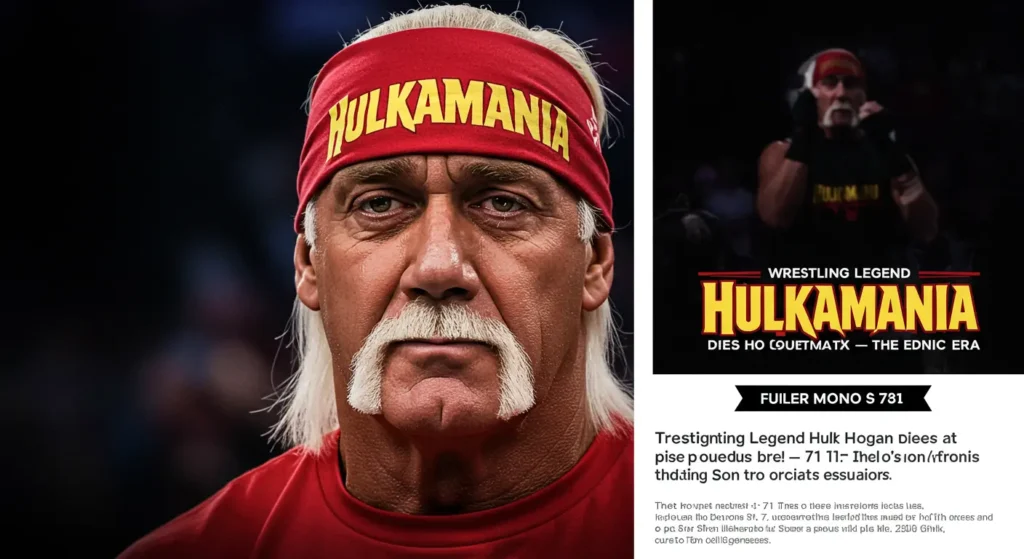Hulk Hogan Passes Away at 71: End of an Era in Professional Wrestling
The wrestling world is in mourning. Hulk Hogan one of the most iconic figures in the history of sports entertainment died Thursday morning at the age of 71 in Clearwater, Florida. Known as the man who helped transform wrestling into a mainstream sensation, Hogan leaves behind a legacy that spans generations, crossing over from the wrestling ring to the global stage.
Final Moments and Cause of Death
Authorities in Clearwater responded to a 911 call on Thursday morning reporting a cardiac arrest. Hulk Hogan, whose real name was Terry Bollea, was rushed to a nearby hospital where he was pronounced dead. According to officials, no foul play or suspicious activity was involved in his death.
WWE confirmed his passing in a heartfelt post, describing Hogan as “one of pop culture’s most recognizable figures” and a major force behind WWE’s explosion in the 1980s. “WWE extends its condolences to Hogan’s family, friends, and fans,” the statement read.
A Wrestling Career That Changed the Game
Hulk Hogan’s contribution to professional wrestling is nothing short of revolutionary. Bursting onto the national scene in the 1980s, Hogan quickly became the face of the then-WWF (now WWE). His charisma, unmatched presence, and unforgettable catchphrases like “Whatcha gonna do, brother?!” made him a household name.
He headlined the very first WrestleMania in 1985 alongside Mr. T, squaring off against Roddy Piper and Paul Orndorff. That event pulled in over 1 million viewers via closed-circuit television — an unheard-of figure at the time and launched wrestling into the American mainstream.
But that was just the beginning.
Read Also: https://clubworldcupnow.com/new-zealand-vs-zimbabwe-2025/
WrestleMania III: A Career-Defining Moment
Arguably, Hulk Hogan’s most iconic moment came during WrestleMania III in 1987 when he body-slammed the 520-pound Andre the Giant in front of nearly 80,000 fans at the Pontiac Silverdome. It was a moment that defined not just his career, but the entire sport of wrestling. The rematch on NBC drew an astonishing 33 million viewers, a record that still stands for wrestling viewership.
From Red and Yellow Hero to NWO Villain
In the mid-1990s, as his heroic persona began to fade, Hogan shocked the wrestling world by reinventing himself. Joining WCW, he transformed into a villain “Hollywood” Hogan and founded the infamous New World Order (NWO). This heel turn in 1996 was one of the most talked-about moments in wrestling history.

Sporting black and white instead of his signature red and yellow, Hogan helped usher in a new, edgier era of wrestling that resonated with a more mature, rebellious audience. WCW dominated WWE in ratings for 83 consecutive weeks a feat largely credited to Hogan’s reinvention.
Hogan’s Return and Final Matches
In 2002, Hogan made a dramatic return to WWE, facing off against The Rock at WrestleMania 18. Though cast as a heel, fans couldn’t help but cheer for him, forcing WWE to bring back his beloved red-and-yellow persona. He continued to appear in various roles and was inducted into the WWE Hall of Fame in 2005.
Despite stepping away from wrestling in 2012, Hogan never fully left the spotlight. He remained involved with WWE sporadically and more recently launched Real American Freestyle Wrestling, a new wrestling promotion. He also planned to open a themed bar near Madison Square Garden, cementing his continued love for the business.
Personal Life and Controversies
Terry Bollea’s personal life wasn’t without its struggles. In recent years, he battled persistent back issues and other health problems tied to his decades in the ring.
He also faced public backlash in 2015 when recordings of him using racist language surfaced. WWE swiftly cut ties, but reinstated him as an ambassador three years later after a public apology. He continued to appear occasionally at WWE events, including its Netflix debut show in January 2025, where fan reception was mixed.
In another major controversy, Hogan sued the gossip site Gawker after a leaked sex tape led to a scandal. In a landmark verdict, he was awarded $115 million for invasion of privacy, a case that ultimately contributed to the site’s shutdown.
The World Reacts
Tributes from wrestling legends, celebrities, and political figures poured in following the announcement of Hogan’s death. Ric Flair, Triple H, and other wrestling veterans took to social media to share their sorrow and memories.
Former President Donald Trump, a longtime friend of Hogan’s, called him “a great friend” and “a powerful cultural icon.” Trump also praised Hogan’s 2024 speech at the Republican National Convention, describing it as “one of the highlights of the entire week.”
Frequently Asked Questions
Q1: What caused Hulk Hogan’s death?
A: Hulk Hogan died from cardiac arrest in Clearwater, Florida. Authorities confirmed there was no foul play involved.
Q2: How did Hulk Hogan influence wrestling?
A: Hogan helped bring professional wrestling into the mainstream, headlining the first WrestleMania and transforming the sport’s popularity in the 1980s and 1990s.
Q3: What was Hogan’s most iconic moment?
A: His legendary body slam of Andre the Giant at WrestleMania III remains one of the most memorable moments in wrestling history.
Hogan’s Lasting Legacy
Hulk Hogan wasn’t just a wrestler he was a cultural phenomenon. He appeared in movies like Rocky III, starred in TV shows like Thunder in Paradise, and even had his own Saturday morning cartoon in the 1980s. His influence extended beyond wrestling rings and into the hearts of millions worldwide.
From his iconic theme song “Real American” to his towering physique and electric charisma, Hogan defined an entire era of wrestling. For many, he was the ultimate hero a symbol of strength, resilience, and the belief that good always triumphs.
As fans continue to celebrate his life and career, one thing is certain: Hulkamania will never die.


Pingback: Justin Fields Injured at Training Camp – Will He Miss Week 1?